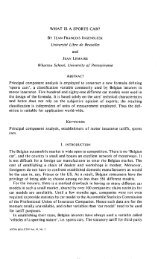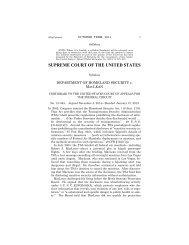85jct_catalan
You also want an ePaper? Increase the reach of your titles
YUMPU automatically turns print PDFs into web optimized ePapers that Google loves.
256 FtiRLINCiER AND HOFBAUFR<br />
up the decreasing piece P’P (coded by a I ) into an ascending one (coded<br />
by a 0), add the remainder (shifted upwards for two units) and call this<br />
path cp( ~2). Apparently cp( W) E S(n + 1, n - 1) and maj cp( W) = maj II‘ -- 1.<br />
It is easy to see that this map is a bijection: Starting with<br />
\I” E S(n + 1, n - I ) we find the critical point P’ to be now the rightmost of<br />
the “deepest” points. [<br />
This implies<br />
Hence<br />
which concludes the proof of (3.5) for i = 1.<br />
Of course the same works also for S _ (n, m) and s(n + 1, m - 1) which<br />
would give q-ballot numbers. These results are due to MacMahon [ 19,<br />
Vol. 2, p. 214; and 20, p. 13451, who called elements of s+(n, m) “lattice<br />
permutations,” but we could not find the above simple combinatorial proof<br />
in the literature. Another proof was given by Aissen [27].<br />
4. q-RUNYON NUMBERS AND A THEOREM OF MACMAHON<br />
Obviously (3.5) is equivalent with<br />
x (qmajw: WE%?,,, des w=k}=i Cn, [;l[k; 1]4LlilI’ t4’l)<br />
As Gessel has pointed out to us, this is actually a special case of the folfowing<br />
result on “sublattice permutations” of MacMahon, stated in [20,<br />
p. 14291: Let<br />
S(a,6;k)=(w~S(a,b):desw=k)<br />
S,(a, b; k) = S(a, b; k) n S,(a, b)<br />
and Ma, 6; 4 = C,, S(o.6;k) q majw and analogously<br />
a Z b,<br />
M, , M- . Then for<br />
M+(a,b;k)=qk2+k<br />
[a-k+l]...[a-l][b-k+l]...[b]<br />
[k]! [k+ l]!<br />
x ([u-k] +q”-““[a-b][k]) (4.2)





